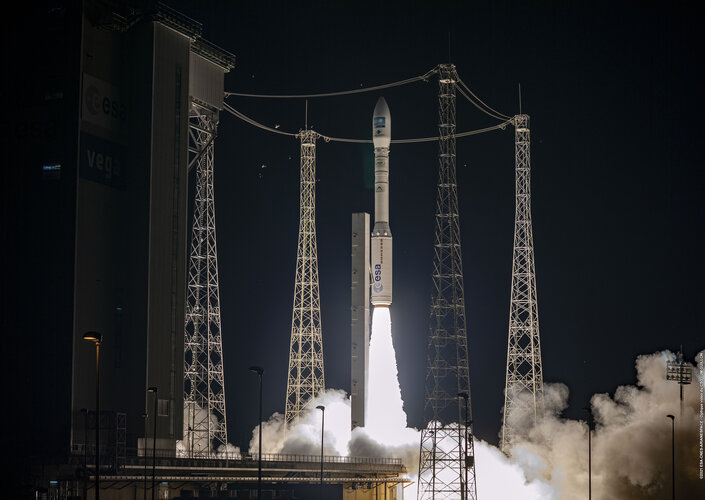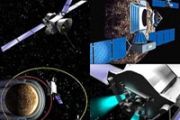
Copernical Team
Nearby star-forming region yields clues to the formation of our solar system
 A region of active star formation in the constellation Ophiuchus is giving astronomers new insights into the conditions in which our own solar system was born. In particular, a new study of the Ophiuchus star-forming complex shows how our solar system may have become enriched with short-lived radioactive elements.
Evidence of this enrichment process has been around since the 1970s, when sc
A region of active star formation in the constellation Ophiuchus is giving astronomers new insights into the conditions in which our own solar system was born. In particular, a new study of the Ophiuchus star-forming complex shows how our solar system may have become enriched with short-lived radioactive elements.
Evidence of this enrichment process has been around since the 1970s, when sc Fizzing sodium could explain Asteroid Phaethon's comet-like activity
 As a comet zooms through the inner solar system, the Sun heats it, causing ices below the surface to vaporize into space. The venting vapor dislodges dust and rock, and the gas creates a bright tail that can extend millions of miles from the nucleus like an ethereal veil.
Whereas comets contain lots of different ices, asteroids are mainly rock and not known for producing such majestic disp
As a comet zooms through the inner solar system, the Sun heats it, causing ices below the surface to vaporize into space. The venting vapor dislodges dust and rock, and the gas creates a bright tail that can extend millions of miles from the nucleus like an ethereal veil.
Whereas comets contain lots of different ices, asteroids are mainly rock and not known for producing such majestic disp Jeff Bezos' rocket company sues, creates additional delay for moon landing
 Jeff Bezos' rocket company, Blue Origin, has sued the U.S. government in federal court to overturn NASA's decision awarding SpaceX a contract for a lunar lander - an action likely to further delay a U.S. return to the moon.
Bezos' company asked permission to file the suit under seal Friday, and U.S. Federal Claims Court Judge Richard Hertling approved that motion Monday morning.
Jeff Bezos' rocket company, Blue Origin, has sued the U.S. government in federal court to overturn NASA's decision awarding SpaceX a contract for a lunar lander - an action likely to further delay a U.S. return to the moon.
Bezos' company asked permission to file the suit under seal Friday, and U.S. Federal Claims Court Judge Richard Hertling approved that motion Monday morning. Trio of orbiters shows small dust storms help dry out Mars
 By combining observations from three international spacecraft at Mars, scientists were able to show that regional dust storms play a huge role in drying out the Red Planet. Dust storms heat up higher altitudes of the cold Martian atmosphere, preventing water vapor from freezing as usual and allowing it to reach farther up.
In the higher reaches of Mars, where the atmosphere is sparse, wate
By combining observations from three international spacecraft at Mars, scientists were able to show that regional dust storms play a huge role in drying out the Red Planet. Dust storms heat up higher altitudes of the cold Martian atmosphere, preventing water vapor from freezing as usual and allowing it to reach farther up.
In the higher reaches of Mars, where the atmosphere is sparse, wate Musk says next Moon landing will probably be sooner than in 2024
 NASA reportedly paid $300 million to SpaceX on 30 July to turn Starship into a crewed Moon lander for its Human Landing System (HLS) programme. In total, the project may require up to $3 billion in funding.
Once again, Elon Musk has shared his optimistic views on space exploration, saying that Moon travel may be closer than it seems. Replying to the Twitter account "Everything Artemis", wh
NASA reportedly paid $300 million to SpaceX on 30 July to turn Starship into a crewed Moon lander for its Human Landing System (HLS) programme. In total, the project may require up to $3 billion in funding.
Once again, Elon Musk has shared his optimistic views on space exploration, saying that Moon travel may be closer than it seems. Replying to the Twitter account "Everything Artemis", wh Vega launches Pléiades Neo and CubeSats

Europe’s Vega has delivered Pléiades Neo-4 and four auxiliary payloads, SunStorm, RadCube and LEDSAT developed through ESA, and BRO-4, to their planned orbits.
The search for life on Mars expands to studying its moons

A pair of researchers at the Japan Aerospace Exploration Agency (JAXA) has published a perspective piece in the journal Science outlining the efforts being conducted this decade to find out if Mars once hosted life. In their article, Ryuki Hyodo and Tomohiro Usui outline the three main efforts that are involved in looking for evidence of life on Mars over the next ten years, and explain why they and others at JAXA believe the best chance of finding evidence of life on Mars lies on one or both of its moons.
As Hyodo and Usui note, NASA is currently conducting a study of the Jezero Crater on the surface of Mars with its Perseverance rover.
Amyloid fibrils experiment operating aboard International Space Station

A novel experiment aimed at studying the mechanics of amyloid fibrils—a type of protein aggregation associated with diseases like diabetes, Alzheimer's, and Parkinson's—started today aboard the International Space Station (ISS), led by a team at Rensselaer Polytechnic Institute.
The project was designed by Amir Hirsa, a professor of mechanical, aerospace, and nuclear engineering at Rensselaer and member of the Center for Biotechnology and Interdisciplinary Studies (CBIS). He was looking for a way to study fluid dynamics without interference from the solid walls of a container, which would typically be necessary to hold a fluid being studied on Earth.
The concept, which Hirsa calls a ring-sheared drop, requires a microgravity environment, like the one found in orbit, where surface tension alone can hold a drop of liquid together. This will allow researchers to observe the effects of stress on protein—in this case: insulin.
"We're trying to understand this particular form of protein aggregation," Hirsa said. "And we're trying to remove the complication of wall nucleation."
The ring-sheared drop hardware—built by NASA and its contractors, and inspired by Hirsa's concept—includes a syringe that dispenses a large drop of liquid made up of water and dissolved insulin.
Watch Vega launch live

Tune in to ESA Web TV from 02:37 BST / 03:37 CEST on 17 August to watch the Vega launch live.































